Your trailer hitch is something that you do not want to get off the discount shelf. You quite literally have a lot riding on your trailer hitch, so why end up with something that you have to worry about?
These trailer hitches come with high pull weighs, top notch warranties, and durable construction from brands that you can trust.
This isn’t a purchase that you should just leave up to anybody, so we’ve done the research for you—find out everything you need below, and select from the five best trailer hitches available.
Here’s Our Top Pick
EAZ LIFT 48058
- Weight Distribution Hitch Kit: Designed to provide trailers with a...
- External/Adjustable Sway Control: The sway control is manually...
- Kit Includes: A round bar weight distributing hitch, sway control, and...
Why is it better?
- Adjustable hitch allows for better fine-tuning of towing setup
- Sway control included pre-installed with system
- Manufacturer’s 5-year warranty helps provide peace of mind
5 Best Trailer Hitches For RV
With that in mind, let’s now take a closer look at our top picks.





Let’s dive into the specifics and review each RV trailer hitch individually. You can use the list below to jump and review specific models, or you can read along and go through all the information.
Best Overall: Camco Eaz-Lift Trailer Hitch
- Weight Distribution Hitch Kit: Designed to provide trailers with a...
- External/Adjustable Sway Control: The sway control is manually...
- Kit Includes: A round bar weight distributing hitch, sway control, and...
When selecting top choice products, we look for that perfect blend of product performance and price.
That is, exactly, what we found with the Camco Eaz-Lift Elite.
Not only did it accomplish its purpose of better weight distribution and handling, we loved the ability to turn off the sway control for towing around town or other situations where having it on can actually diminish control.
Pros
- Adjustable hitch allows for better fine-tuning of towing setup
- Sway control included pre-installed with system
- Manufacturer’s 5-year warranty helps provide peace of mind
- Affordable price
Cons
- Independent, friction, sway control bars can add to installation time
- Chain links can be difficult for some to engage onto bracket
Features
- Eaz-Lift sway control produces less noise than cam operated systems
- Sway control can be turned on-off based on driving conditions, no removal of bar required
Product Information
- 34” x 12 ½” x 8”
- 96 pounds
- Maximum gross trailer weight (GTW) = 10,000 lbs.
- Maximum tongue weight (TW) = 1,000 lbs. (options avail. for 600, 800, & 1,200 lb.)
- 2-5/16” hitch ball
- Adjustable ball mount – Yes
- 5-year warranty
Husky 32218 Trailer Hitch
- INTEGRATED SWAY CONTROL - Combines weight distribution and sway...
- EASY INSTALLATION - Universal EZ adjust frame brackets for easy...
- LIGHTER WEIGHT - Significantly lighter weight than competing products
While the Husky Center Line comes in close to $100 more expensive than the Camco Eaz Lift, it may be the most universal hitch available.
We love how it can be used for a wide range of tongue weights that would require different units in other brand hitches.
This is great feature if you’re TW changes with additional cargo or vehicle modifications.
Pros
- Combines weight distribution and sway control into a single unit – no additional mounting required
- Forged and hardened steel components provide excellent long-term durability
Cons
- Despite being marketed as light, this was the heaviest hitch that we reviewed
- Friction can reach harmful levels if used when reversing – might require disconnecting each time you back into your site
Features
- Designed for reduced noise output compared to competing sway control products
- Lightweight design and pre-installed hitch ball, properly torqued, make for easy installation
Product Information
- 36 ½” x 13.2” x 8.6”
- 116 lbs.
- Maximum GTW = 12,000 lbs.
- Maximum TW = 1,200 lb. (same unit can be used for 800-1,200 lb. range)
- 2-5/16” hitch ball
- Adjustable ball mount – yes
- Limited lifetime warranty
Reese Pro 49903 Trailer Hitch
- Your purchase includes One Reese Weight Distributing Kit | Head with...
- Hitch ball – 2-5/16” | Fits up to – 7” Trailer Frames | Weight...
- Fabricated head and welded hitch bar | 10 year limited warranty | Fits...
This is an impressive value option offering everything you need and nothing that you don’t.
If you don’t need the hydraulic brake capability of higher-end sway control systems, then this hitch might be perfect.
We think this hitch would work best for folks towing less than 6,000 lbs., otherwise you would still need to purchase an additional sway control bar.
Pros
- Everything needed for installation and mounting is included
- Friction sway control bar included
Cons
- Despite being marketed as light, this was the heaviest hitch that we reviewed
- Friction can reach harmful levels if used when reversing – might require disconnecting each time you back into your site
Features
- Fabricated head and welded bars
- Separate sway control bar can be left off if not needed
Product Information
- 33 ½” x 11.2” x 7 ½”
- 102 lbs.
- Maximum 10,000 GTW
- Maximum 1,000 TW (models available for 550, 600, 750, 800, 1,000, and 1,200 lbs.)
- 2-5/16” hitch ball
- Adjustable mount – yes
- 10-year limited warranty
Fastway e2 Trailer Hitch
- THE COMPLETE SOLUTION by offering Built-in Sway Control Without...
- SWAY CONTROL AND WEIGHT DISTRIBUTION IN ONE SYSTEM: Reducing...
- NO BACKING OR TURNING RESTRICTIONS: No matter the weather or...
Honestly, this could have easily been our top pick and clearly others agree.
The Fastway hitch received some of the highest customer satisfaction rates among the weight distribution hitches that we reviewed.
The integrated, dual-point sway control is much easier to install than a chain system and it came in at the lightest weight.
Pros
- 2-point sway control integrated into hitch
- Lightweight design makes for easier storage and installation
- Easier to install than chain hitches and compatible with surge or hydraulic trailer brakes
Cons
- The hitch ball is not included with this set
- Still only reacts to sway, does not necessarily prevent it entirely
Features
- 10-year warranty confirms that this hitch is capable of handling your weight distribution needs for many years
- There are no backing or turning restrictions, as is commonly seen with add-on bars
Product Information
- 10 ½” x 33” x 6”
- 82 lbs.
- Maximum GTW = 8,000 lbs.
- TW Rating = 800 lbs.
- Hitch ball not included
- Adjustable mount – yes
- 10-year warranty
Equal-I-Zer 90-00-1000
- Our Integrated 4 Point Sway Control provides the highest level of...
- The Equal-i-zer hitch's weight distributing design effectively...
- The Equal-i-zer hitch gives you a safer ride by providing both sway...
If you’ve experienced significant control concerns with your RV in the past, regularly tow heavy loads, or are just looking for the maximum protection available, then the Equal-i-zer hitch might be perfect.
For the average customer towing their RV, however, we’re not sure the cost is worth the nominal performance increase.
Pros
- 4-way sway control for maximum sway protection
- Versatile use with most trailer styles, RV’s, horse trailers, boat & cargo haulers, etc.
- Sway control and weight distribution are integrated into one system – no need for additional parts, mounting brackets, etc.
Cons
- Hitch ball is not included with this hitch
- Cost – This was the most expensive hitch that we reviewed
Features
- Industry-leading weight distribution for a smooth ride and maximum control while driving
- Lifetime warranty demonstrates Equal-i-zer’s quality expectations
Product Information
- 60” x 16” x 16”
- 102 lbs.
- Maximum GTW = 10,000 lbs.
- TW = 1,000 lbs.
- Hitch ball not included
- Adjustable mount – yes
- LImited lifetime warranty
Types Of RV Trailer Hitches
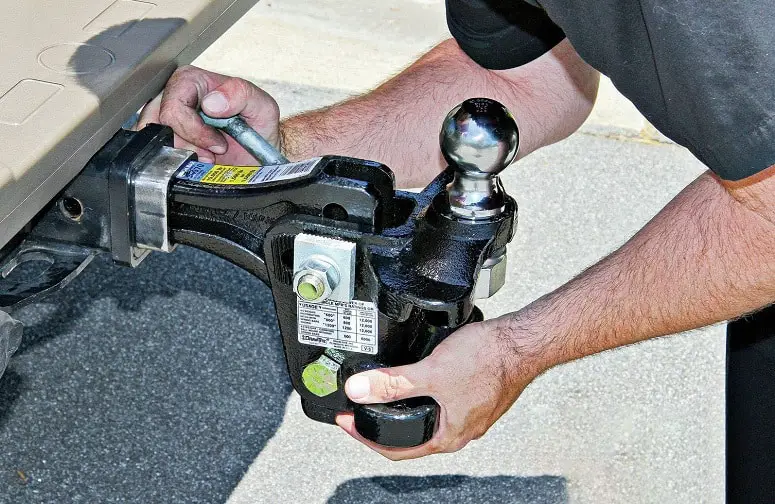
You may have the perfect camper, and you may have the perfect truck or SUV to tow it, but without the proper hitch, your dream of new adventures and life on the road will remain just that, a dream.
Selecting the proper hitch to tow your new RV may just be the single most important element to safe and happy camping, and it’s easy to see why.
Towing anything down a highway carries considerable risk, whether it’s a bicycle rack or a farming trailer.
When you add a 4,000 – 8,000+ lb. RV or fifth wheel trailer to the equation, you’re entering a whole new level of risk, not just to your valuable, mobile home, but to the thousands of motorists that will be sharing the road with you while cruising along at 65 mph.
With discussions highlighting different hitch styles, classes, and weight capacities, you’ll soon feel confident in choosing the right match for your RV towing needs.
While we have described numerous hitch types below to help with your understanding of what is available, this guide will be focused on weight distribution hitches, the industry leading selection for RV towing.
Receiver Hitch
Already pre-installed on many trucks and large SUVs, the receiver hitch is the most common hitch installed on vehicles.
Receiver hitches are mounted directly to your tow vehicle’s frame and feature a square receptacle (size will vary) for insertion of tow accessories, whether it be a bike rack or a fully featured weight distribution hitch.
Class 1-5
Receiver hitches are broken into varying classes which will determine the hitches’ maximum tow capacity, as well as the size of its square receptacle.
- Class 1
- 1 ¼” x 1 ¼” receiver
- Gross tow weight (GTW) up to 2,000 lbs.
- Best suited for smaller cars and light loads (bike racks, ski carry, cargo trays, etc.)
- Class 2
- 1 ¼” x 1 ¼”
- GTW up to 3,500 lbs.
- Increased weight capacity is main difference in stepping up from class 1
- Class 3
- 2” x 2”
- GTW up to 8,000 lbs. (can be 12,000 lbs. with a weight distribution addition)
- Class that is most commonly seen with full size trucks and SUVs
- Class 4
- 2” x 2”
- GTW up to 10,000 lbs. (14,000 with weight distribution system)
- Also commonly seen on full size pickup trucks for larger hauling tasks
- Class 5
- 2” x 2” or 2 ½” x 2 ½”
- GTW up to 20,000 lbs.
- For premium, heavy duty trucks with engines capable of handling heavy weight towing tasks (construction uses, equipment haulers, etc.)
5th-Wheel Hitch
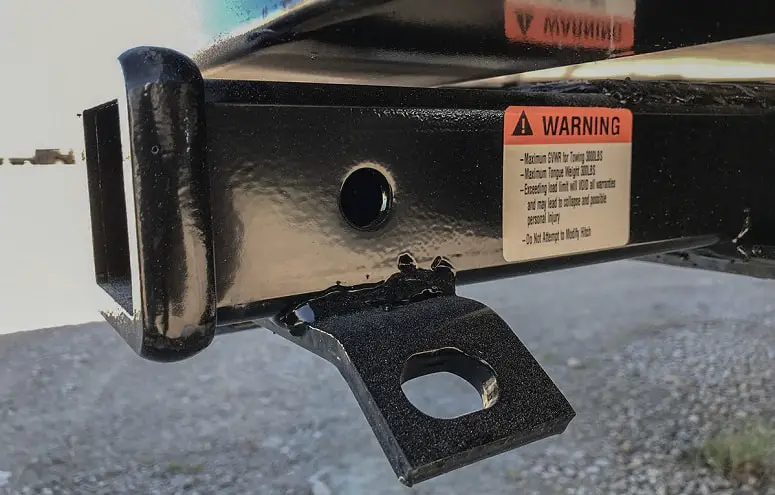
This is a heavy-duty hitch that mounts directly within the bed of a pickup truck and is centered over the rear axle.
They are designed to receive the kingpin from your RV and have large carrying capacities from 16,000 – 25,000 lb. capacities.
Unfortunately, they do take up significant cargo space within your truck bed when not in use.
Many RVers still prefer a 5th-wheel hitch, however, as they tend to be more stable on the road than many traditional tongue hitches.
Gooseneck Hitch
As a solution to the common downsides of a 5th-wheel hitch, a gooseneck hitch usually involves a standard-looking ball mount installed just forward of a truck’s rear axle.
This allows for large towing capacities when needed, yet maintains near maximum cargo capacity within the bed of the truck when not.
A gooseneck hitch could be the preferred choice if you use your truck commercially, say as a construction worker or contractor, in addition to your RV camping needs.
Bumper Hitch
Limited to the weight capacity of your vehicle’s bumper, these hitches should not be considered for any real towing solutions beyond a lightweight rack for beach supplies or camping gear.
Receiver Hitch Accessories
Weight Distribution Hitch
A weight distribution hitch, which is inserted as an accessory/addition to a standard receiver hitch, helps maintain an even weight distribution onto your vehicle’s and camper’s axles.
They are shaped in a ‘v’ orientation with two spring bars that connect trailer to tow vehicle.
Higher end models will, also, include sway control measures.
Ball Mount Hitch
A ball mount hitch is the most common and affordable way to tow a trailer, boat, rv, or pop-up camper.
It features a steel sphere (the ‘ball’) connected to a metal bar that is inserted into your vehicle’s receiver hitch.
Combined with a trailer coupler of the matching size, the ball mount hitch allows a secure connection and ample pivoting ability as you turn corners.
When Do You Need A Weight Distribution Hitch?
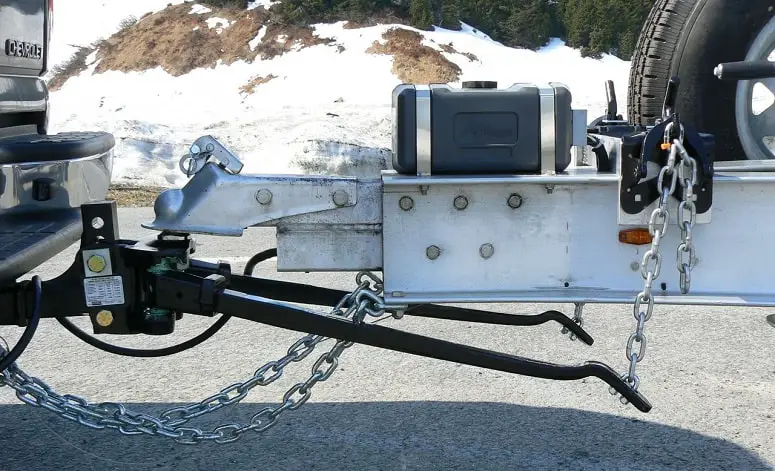
In reality, a weight distribution hitch can be a valuable addition to your towing setup if any of the following conditions are met:
- When connected, your vehicle’s front tires lose pressure with the pavement
- You notice diminished control when pulling your rv
- The back end of your vehicle is lower than the front end once your trailer is connected
- You, often, experience stressful trailer sway while traveling
- Your gross trailer weight (GTW) is 50%+ of your tow vehicle weight
- You would like to ensure that you can tow at the maximum weight capacity of your hitch
Common Signs That Your RV Is Too Heavy For Your Current Towing Setup
There are a few common indicators that can help you justify the upgrade to a weight distribution system.
Upgrading to a weight distribution hitch will, typically, increase your class 3 or 4 hitch GTW capacity by more than 40%.
Front Bumper Rise
Measure the distance that your front bumper sits above level ground before and after connecting your RV.
If the difference is more than ½”, you would benefit from a weight distribution system.
Control Loss While Towing
If you notice less control with your vehicle while towing your RV, then there’s a good chance it’s time for a towing system upgrade.
Poor Ground Clearance/Scraping At Hitch Connection
If you’ve noticed that the bottom of your hitch, often, scrapes against the ground when going over small curbs or surface changes in the pavement, then it’s time for a weight distribution hitch.
Understanding How A Weight Distribution Hitch Works
Unlike single axis bar attachments, like with a standard ball mount hitch, weight distribution hitches utilize dual spring bars to better leverage the tongue weight of your RV.
Rather than transferring your RV’s tongue weight directly onto your vehicle’s rear axle, this system allows for the weight to be distributed evenly among each axle throughout the RV and tow vehicle.
What Parts Come With The PUrcahse of a Weight DIstribution Hitch Kit?
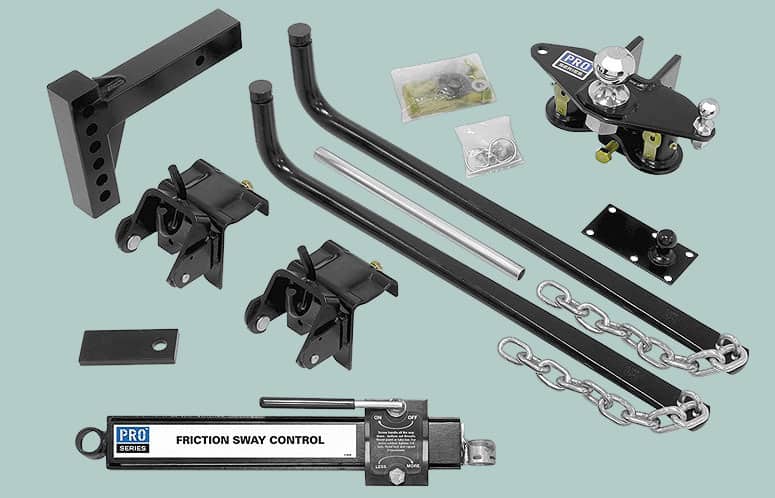
- Weight distribution shank – Inserted into your vehicle’s receiver hitch, providing an attachment point for the distribution system’s head
- Head assembly – This is where the ball hitch is mounted and provides the main point of attachment for your trailer. The head is connected to the vehicle via the bolt holes on either side of the weight distribution shank
- Spring bars – These are the two levers that handle the bulk of your weight distribution. They are connected to the head assembly on the back of your vehicles and then to your RV’s frame, either with chainlinks or integrated brackets.
- Sway control mounting brackets – Your kit will include two brackets designed to be mounted on each side of your RV’s hitch frame. This is where the spring bars will be attached.
- Hitch ball – Some hitch kits already come with the ball included. If not, you will need to purchase it separately in order to use your weight distribution hitch.
- Sway control bar – Not included with every hitch kit and designs can vary. A standard independent, friction-based sway control bar is a separate cylindrical, telescoping bar that will need to be mounted between the RV and hitch head. Also, you may need to purchase an additional control bar depending on the GTW of your RV
- Leverage bar/Load lifter – Some kits will include a bar designed to help you pull the chains and bracket up into their final, seated position whilst under tension. This, also, applies to hitches that featured integrated sway control bars that are placed onto a cleat, without the use of chainlinks
Benefits Of A Weight Distribution Hitch For Towing Your RV
Increased Traction And Control
Since the engine is located over the front axle in most vehicles, a disproportionate downward force on the rear axle, as is often the case without a weight distribution system, will cause a loss in control as the front tires are raised.
This can be a very unsettling feeling while driving down the road with a large RV in the rear-view mirror.
A weight distribution hitch prevents overloading of the rear axle, and allows you to maintain good FWD or AWD control with your vehicle.
Better Ground Clearance At Connection Points
Ensure that your hitch, front portion of your RV, and rear bumper of your vehicle all stay above the pavement during surface changes or small bumps with a weight distribution hitch.
Reduced Sway
One of the scariest moments as an RV owner is the first time that you experience trailer sway on the highway.
Whether it was caused by a gust of wind or a surface imperfection in the pavement, the loss of control from trailer sway is a serious catalyst to many RV accidents.
Prevent this sway, or limit it significantly, with a weight distribution hitch. Many models feature integrated sway control components and even those that don’t can be outfitted with accessory bars for the same purpose.
Increased Towing Capacity
The use of a weight distribution hitch is one of the only ways to instantly increase your towing capacity.
Most class 3 and 4 receiver hitches (what you, likely, have if towing an RV) indicate two GTW capacities, one with and one without the use of a weight distribution hitch.
The capacity available with the system is, usually, 40% – 50% higher than without it.
Connecting Your Weight Distribution Hitch And RV For The First Time
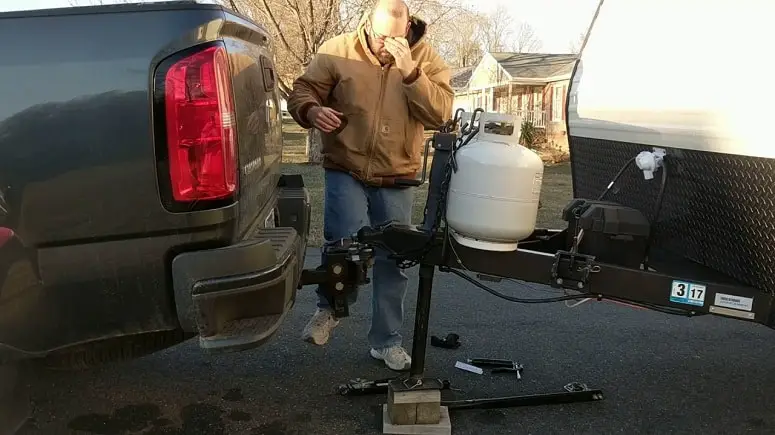
Setting up your new weight distribution hitch for the first time can be intimidating if you have never installed one before.
While the process for installing the hitch is simple enough to tackle on your own, the consequences of getting it wrong are, obviously, high.
We, strongly, recommend having a professional walk you through installation and hook up the first time you attempt to connect your RV.
For those of you who already have experience with hitch installations or are feeling confident with your DIY skills, check out our guide below for the steps necessary to connect your weight distribution hitch.
*NOTE: If you are unsure as to which part of your hitch we are referring to at any point below, look back at our weight distribution hitch part descriptions seen above
- Back your tow vehicle up into a preliminary towing position, still leaving 2-4 feet between your RV’s coupler and your truck’s receiver. This will allow for easier comparison between your trailer coupler height and your truck’s receiver hitch.
- Insert your hitch’s bracket into the square receiver of your truck or SUV. Whether you orient the bracket in an upward or inverted direction will depend on the height difference between your trailer coupler and truck hitch.
- Align the head assembly of your hitch, complete with ball mount, onto the bracket that you installed during the previous step. Ideally, the ball will sit 1” – 3” above the height of your RV’s coupler.
- Place flat washers onto the adjustment rod head (most hitches come with 2 heads of slightly varying height) and place it into the center hole on the inside of the head assembly. Pivot the head back up into position and confirm that the ball is sitting in a vertical orientation, or slightly away from the vehicle, when the adjustment rod is tight against the shank. Make adjustments if necessary.
- Secure the head assembly to the shank with the provided hex bolts, washers, and nuts and proceed to tighten the top bolt/nut so that the head is firmly connected to the shank.
- Grab the two spring bars that came with your hitch kit. Depending on the model, you may have to install the chainlinks.
- On the truck end of the spring bars (without the chains) there will be two knobs that need to be placed within matching pockets on the head. Flick the latch lock to keep the bars in place
- It is now time to connect your RV by raising the coupler and reversing your truck until the ball mount is aligned directly underneath
- Using the jack lever, lower the coupler onto the ball mount until you are able to secure it with the latch
- Align where the chain will hang perpendicular to the arm of the trailer and make note of where you will need to install each chain lift bracket.
- Secure the lift brackets in place with the provided bolt, tightening it ¼ turn after it makes contact with the frame
- Once again using the trailer’s jack, raise the level of the trailer a few cranks to allow for easier placement of the spring bar chains
- Now, you will hook the appropriate chain link onto the hook within the center of the lift bracket. The spring bars should be parallel to the RV frame and have a minimum of 5 links out between the bar and hook
- Make sure to clamp the lift brackets upward so that they are fully seated against the bracket. This is done with the lift lever attachment bar, which provides additional leverage for doing this under tension. Secure this position with a latch key on both brackets
- You can now lower the trailer jack so that your RV’s weight is fully supported by the hitch and tow vehicle. This is now the time to confirm how the weight distribution is performing. Do you see significant change in your vehicle’s ground clearance in the front/rear? If so, make the necessary adjustments to your hitch setup (fewer links out on spring bars or an angle change with the head & ball mount can usually accomplish this)
- Torque bolts to their final specified amounts and you are ready to tow
Factors To Consider When Purchasing A Weight Distribution Hitch For Your RV
Tow Capacity
Your ultimate towing capacity will depend on several factors, such as your vehicle’s build quality, engine design, and what type/class of hitch you have installed.
First, you’ll need to confirm that your vehicle’s tow capacity matches or exceeds that of your RV.
The addition of a hitch, regardless of type, will never increase your vehicle’s overall towing capacity.
Ideally, you are aware of this number before purchasing a new RV.
I have known multiple RV owners who bought a new camper, only to realize that their current truck was not rated to haul the additional weight.
A forced truck upgrade may seem exciting, but it, also, adds a considerable expense right after the purchase of your new RV.
Gross Trailer Weight (GTW)
This number references the fully loaded weight of your RV in the condition that it will be towed.
This number should never exceed your vehicle’s tow capacity (TC).
As we mentioned above, you will, also, need to determine your tongue weight when selecting a weight distribution hitch.
Tongue Weight (TW)
Tongue weight is, essentially, the amount of force placed upon your hitch once your RV is connected to your vehicle.
It is a combination of your RV’s weight near the front and the cargo weight stored in the back of your tow vehicle (behind the rear axle).
It is imperative that you measure this number correctly, so that you can choose the right hitch rating.
Total TW (for use in buying a weight distribution hitch) = RV Tongue Weight + Vehicle cargo weight behind rear axle
If you buy a weight distribution hitch too far above your tongue rating, it is possible to end up with an overly stiff system that can compromise the hitch’s function.
Conversely, if you purchase a hitch with a tongue weight rating too low, it won’t be safe to operate.
Your RV’s tongue weight rating should be listed within the owner’s manual, as well as on the label found on the front hitch frame of the RV. Remember to consider the weight of full tanks, if you, frequently, travel that way.
Ease of Installation

Most weight distribution hitches have similar installation steps, however, there are some key differences that will make some way more suited to self-installation.
Any system that utilizes independent friction sway control (the separate bar that comes with many kits) will require more time and hardware to install than those whose sway control is integrated into one system.
Additionally, the bar will need to be removed from the hitch before reversing the RV or navigating tight turns, which can be an inconvenience.
Most RV owners agree that the dependent, or integrated, sway control systems are easier to install than the traditional chain link connections.
Ground Clearance
If you are concerned with ground clearance, trunnion style spring bars, as opposed to round, will give you the greatest clearance as you navigate over changes in pavement or bumps in the road.
Maneuverability
It may seem counter-intuitive, but there are a few situations where an additional sway control element can, actually, hinder your safety when towing an RV.
For tight turns in reverse or ‘jackknifing’ your trailer into a campsite or storage location, it is recommended that you remove any independent sway control bars.
Not every hitch system will have this restriction and so you may wish to confirm this detail if you frequently reverse your RV at sharp angles.



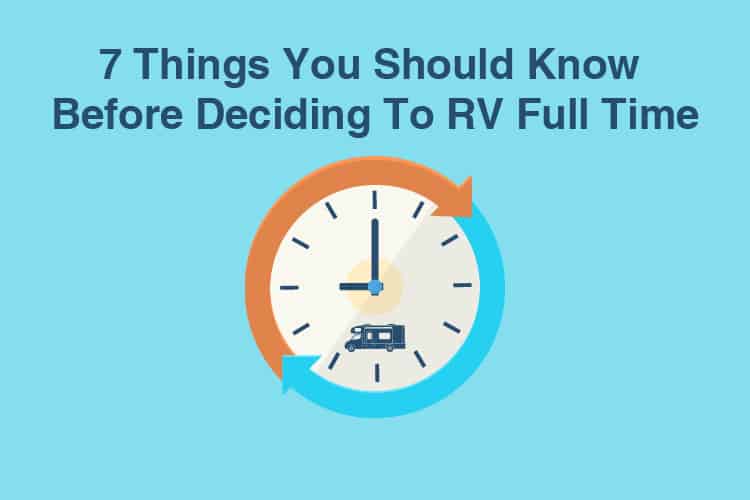

We just bought a new Grand Design travel trailer. The GVWR is 8895 lbs. The dealership is telling us that the Blue Ox is our best bet for a hitch. Do you agree? There price is about $750 plus installation. This a lot more that your recommended EAZ Lift 48058. Any advice?